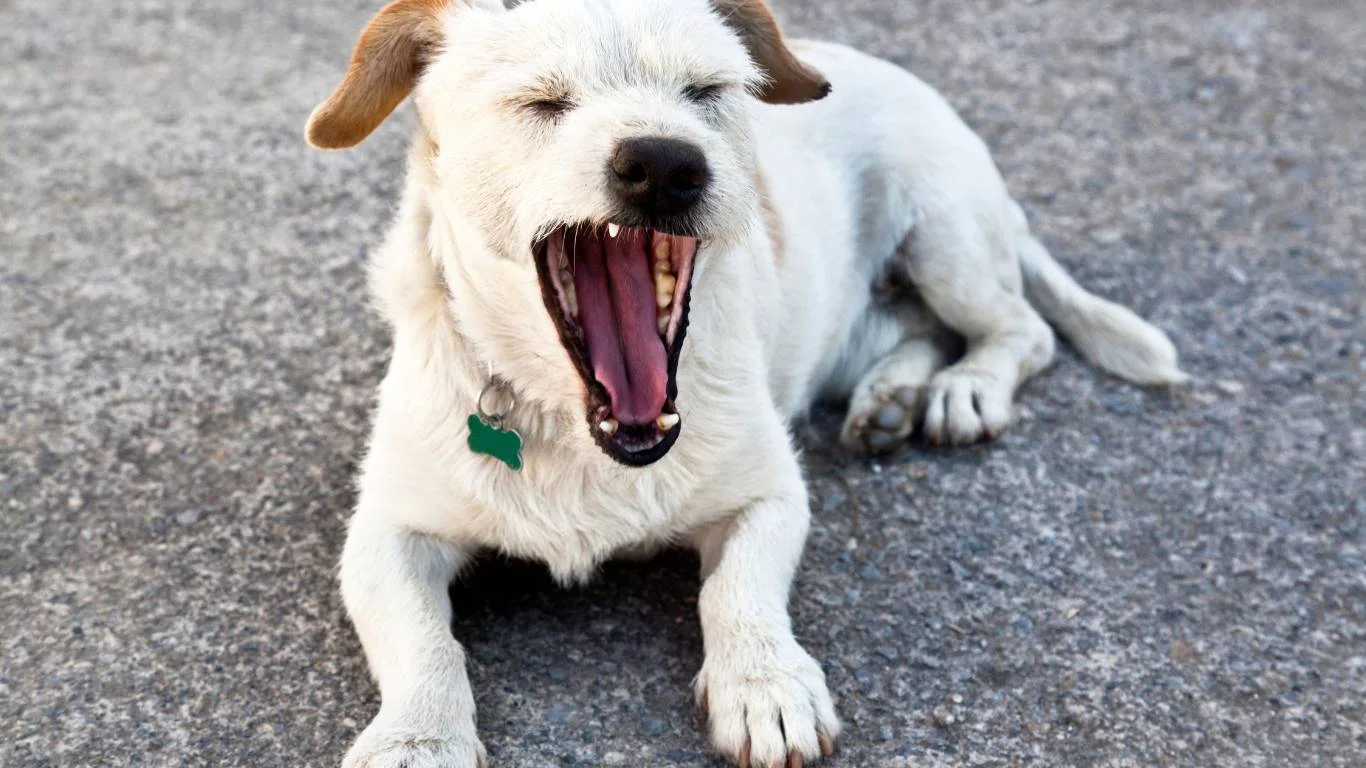What to Do If Your Dog Has a Swollen Abdomen: 5 Key Treatments
If you’ve ever found your dog’s belly unusually swollen, you know it can be a scary experience. As a pet nutritionist and someone who’s worked in veterinary clinics for years, I’ve seen many concerned pet parents rush in with this exact question: “What to do if your dog has a swollen abdomen?” First, take a deep breath, because you’re not alone in this. Many dogs go through this issue, and while it’s often a cause for concern, it’s not always as urgent as it may seem. That said, it’s crucial to understand the underlying causes of a swollen abdomen and how to act quickly if it happens to your furry friend.
Why Does a Dog’s Abdomen Swell?

A swollen abdomen in dogs can result from various health issues, ranging from something simple to something more severe. As a pet care expert, I’ve encountered all sorts of causes during my time in veterinary clinics. Let’s explore some of the potential reasons your dog’s abdomen might be swollen:
1. Bloat (Gastric Dilatation-Volvulus)
Bloat, also known as gastric dilatation-volvulus (GDV), is one of the most serious causes of abdominal swelling in dogs. This condition occurs when a dog’s stomach fills with gas and twists, leading to severe bloating. GDV can progress quickly and is often fatal without prompt treatment. Symptoms include a distended belly, restlessness, drooling, rapid breathing, and vomiting. If you suspect bloat, immediately contact your vet or go to the nearest emergency clinic. Time is of the essence in this situation.
2. Fluid Accumulation (Ascites)
If your dog’s belly looks swollen and feels soft, the cause may be fluid buildup, commonly known as ascites. This could be caused by a variety of health issues, including heart failure, liver disease, or kidney problems. Ascites can result from fluid leaking out of blood vessels or from problems with the heart or liver not working efficiently. The fluid buildup causes the abdomen to become visibly enlarged and may cause discomfort. Your vet will need to perform tests to diagnose the root cause of fluid accumulation.
3. Organ Enlargement
In some cases, the swollen abdomen could be due to an enlarged organ, such as the liver or spleen. If an organ becomes enlarged due to disease, it can cause noticeable bloating. Tumors, infections, or inflammation might be the cause of the organ enlargement. Your veterinarian will typically use imaging, like X-rays or ultrasounds, to determine which organ might be enlarged and to pinpoint the underlying issue.
4. Internal Bleeding
Another potential cause of a swollen abdomen is internal bleeding, which can result from trauma, a ruptured organ, or certain blood disorders. If your dog has had a recent accident or injury, it’s essential to get them checked out immediately. Signs of internal bleeding may include weakness, pale gums, and a distended belly. This is an emergency situation, and you should contact your vet right away.
5. Constipation or Digestive Issues
On a less severe note, constipation or digestive issues can also cause bloating. Sometimes, if your dog is having trouble passing stool or gas, their abdomen can appear swollen. If your dog’s belly is hard to the touch and they haven’t had a bowel movement in a while, constipation could be the issue. A visit to the vet will help get things back on track, but in the meantime, some minor adjustments to their diet can help ease the problem. More fiber, hydration, or a gentle laxative prescribed by your vet can make all the difference.
Signs You Shouldn’t Ignore

If you notice that your dog’s abdomen is swollen, it’s important to watch for additional signs that indicate the severity of the issue. These signs will help you determine whether it’s a simple issue or an emergency. Keep an eye out for the following:
- Vomiting: Frequent vomiting can point to an underlying issue like bloat, infection, or gastrointestinal problems.
- Rapid breathing or panting: Difficulty breathing or excessive panting can be signs of pain, distress, or bloat.
- Restlessness: If your dog is pacing, drooling, or acting unusually uncomfortable, it’s a red flag.
- Discomfort when touched: If your dog seems to be in pain when you touch their abdomen, it’s best to get them checked out.
- Pale or blue gums: Gums that are pale or blue can be indicative of poor circulation and possibly internal bleeding.
What to Do If Your Dog’s Abdomen is Swollen
So, now you know a little about what could be causing the swelling in your dog’s abdomen, but what do you actually do when you see it? The most important thing is don’t panic. Your dog might be uncomfortable, but staying calm will help you take the right steps.
Here’s what to do:
- Observe your dog carefully: Look for any signs of distress such as vomiting, excessive panting, or weakness.
- Call your vet: Whether it’s an emergency or just a case of gas or constipation, a professional evaluation is always the best course of action.
- Provide comfort: While waiting for professional help, make sure your dog is as comfortable as possible. Avoid feeding them anything, as it could complicate some conditions.
- Prepare for an emergency visit: If the swelling is severe, or if you notice other concerning symptoms like difficulty breathing or pale gums, prepare for an emergency trip to the vet.

Next Steps: When to Seek Emergency Help
In some cases, you may need to rush your dog to the emergency vet. I’ve had several instances where pet owners waited a little too long to act, and unfortunately, their dogs didn’t make it due to a lack of timely intervention. If you’re in doubt, don’t wait. It’s always better to have your vet check your dog out sooner rather than later.
Diagnosing the Cause of a Swollen Abdomen

Once you’ve noticed that your dog has a swollen abdomen, the next step is getting a proper diagnosis. As a pet nutritionist, I can’t stress enough how important it is to consult your vet for a thorough evaluation. Your vet will use several diagnostic tools to identify the cause, and the process often includes a combination of the following methods:
1. Physical Exam
The first thing your vet will do is give your dog a full physical examination. This may involve feeling the abdomen for signs of pain, discomfort, or abnormal masses. They’ll also check for signs of bloating, fluid buildup, or organ enlargement. While a physical exam can provide valuable clues, it’s usually not enough to make a final diagnosis, so additional tests will likely be needed.
2. Blood Tests
Blood tests are often the next step to rule out infections, liver problems, kidney failure, or blood disorders that could cause abdominal swelling. These tests can provide insights into your dog’s overall health, and help the vet spot any red flags that point to a more severe issue. I’ve seen plenty of dogs diagnosed with infections or kidney disease just by a simple blood test, and early detection can make a huge difference in treatment.
3. Imaging (X-rays, Ultrasound)
Imaging is crucial in diagnosing the cause of a swollen abdomen. X-rays and ultrasound scans are often used to get a closer look at what’s happening inside your dog’s body. X-rays can help identify issues like bloat, tumors, or gas buildup, while an ultrasound can show if there’s any fluid in the abdomen or if organs are enlarged. Imaging allows your vet to see things that are impossible to detect just by touch or blood work.
4. Fluid Tap
If fluid accumulation is suspected, your vet may recommend a procedure called abdominocentesis, or a fluid tap. This involves using a needle to extract a small sample of the fluid from the abdomen to test for infection, cancer cells, or other abnormalities. This test is particularly useful for diagnosing ascites (fluid buildup) and helps your vet determine the next best steps for treatment.
Treatment Options for a Swollen Abdomen

Once a diagnosis has been made, the appropriate treatment for your dog’s swollen abdomen will vary depending on the underlying cause. Here’s a breakdown of treatment options based on the most common causes of abdominal swelling:
1. Treatment for Bloat (GDV)
If your dog is diagnosed with bloat (GDV), immediate action is necessary. GDV is a medical emergency that requires surgical intervention to untwist the stomach and relieve the gas buildup. This procedure is performed under general anesthesia, and the vet may also take steps to prevent future episodes of bloat, such as attaching the stomach to the abdominal wall (known as a gastropexy). Early intervention is crucial, and I’ve seen many dogs make full recoveries if treated quickly enough. However, if left untreated, GDV can be fatal within hours.
2. Treatment for Ascites (Fluid Buildup)
If your dog has fluid buildup in the abdomen, treatment will focus on managing the underlying cause. For example, if the ascites is caused by liver or heart disease, treatment may involve medications to control the condition, such as diuretics to reduce fluid retention. In some cases, fluid may need to be drained from the abdomen to relieve discomfort, but the fluid will likely build back up unless the root cause is addressed. In some instances, surgery may be necessary if a tumor is causing the fluid buildup.
3. Treatment for Organ Enlargement
If an enlarged organ (like the liver or spleen) is found to be the cause of the swelling, treatment will depend on what’s causing the enlargement. If it’s due to an infection, antibiotics or antifungals might be prescribed. If there’s a tumor, surgery might be the best option. Sometimes, if the enlargement is related to a chronic condition, ongoing medication and care may be necessary to manage the condition over time. I’ve had many clients whose dogs thrived with the proper medication and monitoring, even after a significant diagnosis.
4. Treatment for Internal Bleeding
Internal bleeding is a serious condition that requires immediate intervention. Depending on the severity of the bleeding, treatment may include blood transfusions, surgery, or medication to stop the bleeding. If an injury is the cause of internal bleeding, your vet may need to surgically repair damaged organs or blood vessels. This is another situation where early intervention can mean the difference between life and death, so if you suspect internal bleeding, don’t wait for the swelling to subside before seeking help.
5. Treatment for Constipation or Digestive Issues
If your dog’s swelling is caused by constipation or digestive problems, your vet may recommend dietary changes, increased fiber intake, or gentle laxatives to get things moving again. You might be advised to feed your dog smaller meals more frequently or introduce foods that are easier on their digestive system. In severe cases, an enema or manual removal of stool may be necessary. Luckily, most dogs recover from constipation with minimal intervention and some dietary tweaks.
Home Care and Monitoring Your Dog
After your dog receives treatment, it’s essential to continue monitoring their condition closely. Depending on the diagnosis, your vet may give you specific instructions for aftercare. Here are some general things to keep in mind:
1. Follow-Up Vet Visits
Whether your dog underwent surgery, is on medication, or simply needs monitoring, follow-up visits to your vet will likely be necessary. These visits allow your vet to monitor your dog’s recovery and ensure that everything is healing properly. Don’t skip these appointments, even if your dog seems to be doing well—sometimes complications arise after treatment, and it’s better to catch them early.
2. Diet Adjustments
If your dog’s swollen abdomen was caused by digestive issues, you may need to adjust their diet. This could mean feeding them a high-fiber food, smaller meals throughout the day, or a prescription diet tailored to their needs. Some dogs with liver or kidney problems require special diets to help manage those conditions, so be sure to follow your vet’s guidance on feeding.
3. Watch for Recurrence
Even after treatment, some conditions may recur, particularly if the underlying cause isn’t fully resolved. For example, dogs that have had bloat are at higher risk of it happening again. To reduce the risk of recurrence, keep an eye on your dog’s behavior and belly size, and be mindful of any signs of discomfort or distress. If you notice any worrying symptoms, don’t hesitate to contact your vet right away.

Preventing Abdominal Swelling in Dogs

As a pet nutritionist, one of the most rewarding parts of my job is helping dog owners prevent health issues before they become major problems. While some causes of abdominal swelling in dogs are unavoidable, there are steps you can take to reduce the risk of your dog developing a swollen abdomen. Prevention doesn’t just help your dog stay healthier; it can also reduce the stress and anxiety that comes with worrying about their health. Here are some tips I’ve shared with countless pet parents to keep their dogs’ bellies happy and healthy:
1. Avoid Overfeeding
One of the simplest and most effective ways to prevent bloating (GDV) is to avoid overfeeding your dog. Overeating can lead to excessive gas and bloating, especially in larger breeds. I’ve often seen dogs struggle with this after their owners give them larger portions than needed. It’s important to follow the feeding guidelines provided by your vet or the dog food manufacturer, and never free-feed your dog. Instead, offer several smaller meals throughout the day to aid digestion.
2. Watch for Food Sensitivities
Food sensitivities can be a culprit for digestive issues and, in some cases, bloating. Some dogs might have trouble digesting certain proteins, grains, or dairy. In my experience, switching to a hypoallergenic or easily digestible food can make a world of difference. Keep an eye out for signs of food intolerance like diarrhea, excessive gas, or vomiting, and consult with your vet to find the best food for your dog’s specific needs.
3. Be Mindful of Exercise
After eating, it’s important not to let your dog engage in vigorous physical activity immediately. If your dog has just eaten and you’re planning a walk or playtime, wait at least an hour before starting. This gives your dog’s stomach time to settle and aids digestion. I’ve seen a few cases where dogs have developed bloating because their owners took them for a walk or play session too soon after a meal.
4. Regular Vet Check-ups
Prevention is always easier than treatment, and one of the best ways to catch problems early is through regular vet check-ups. As your dog ages, it’s essential to schedule annual exams with your vet. These check-ups allow for early detection of conditions like heart disease, liver failure, or tumors that could lead to abdominal swelling. Even if your dog is healthy, regular vet visits can help catch any emerging issues before they become critical. I can’t emphasize enough how important it is to stay on top of these appointments.
5. Avoid Excessive Heat and Stress
Both excessive heat and stress can contribute to various health problems in dogs, including bloating and abdominal discomfort. On hot days, ensure your dog has access to fresh water and a cool place to rest. Additionally, reducing stress in your dog’s life can help them maintain their overall health. Dogs that are constantly anxious may experience digestive problems, including bloating. Establishing a calm and stable environment for your dog can help prevent unnecessary stress.
When to Call Your Vet for Help
Even with all the prevention steps in place, things can still go wrong, and it’s important to know when to call your vet for help. Sometimes, early intervention can make all the difference in the outcome of your dog’s health. Here are some signs that should never be ignored:
- Persistent abdominal swelling: If your dog’s belly remains swollen for more than a few hours or seems to worsen, it’s time to get them to the vet.
- Severe lethargy: A dog who is unusually tired, sluggish, or reluctant to move could be in pain or suffering from a serious condition.
- Uncontrollable vomiting: If your dog is vomiting repeatedly and showing signs of distress, don’t wait to call your vet.
- Pale or blue gums: This can indicate a lack of oxygen and is a serious sign that something is wrong inside your dog’s body.
- Difficulty breathing: Any sign of labored or rapid breathing should be taken seriously. This could point to a number of conditions, including bloat or heart failure.
Understanding the Importance of Early Intervention
In my experience, the sooner you catch any signs of abdominal swelling or discomfort in your dog, the better the chance for a successful recovery. Early intervention can make the difference between a minor issue and a life-threatening condition. Whether it’s bloat, fluid buildup, or a digestive problem, don’t hesitate to reach out to your vet at the first signs of trouble.
Living with a Dog with Abdominal Health Issues
While the idea of your dog experiencing health issues can be scary, it’s important to remember that many conditions that cause abdominal swelling can be managed with proper care. After treatment, many dogs return to their normal, active selves. As a pet nutritionist, I’ve worked with pet parents who’ve been able to manage their dog’s health conditions effectively through dietary changes, medication, and lifestyle adjustments. With the right support and care, your dog can still live a happy and healthy life, even if they have to manage a chronic condition.
If you have any concerns or questions about your dog’s health, always reach out to a professional. Whether it’s your regular vet or an emergency clinic, the most important thing is that your dog gets the care they need as quickly as possible.
Disclaimer
The information provided in this article is intended for informational purposes only and should not be used as a substitute for professional veterinary advice. If your dog is showing signs of abdominal swelling, please contact your veterinarian immediately for a proper diagnosis and treatment plan. Always follow your vet’s recommendations and never attempt to diagnose or treat your dog’s health conditions without professional guidance.
For more helpful tips on pet care, nutrition, and health, visit PawPatron.






